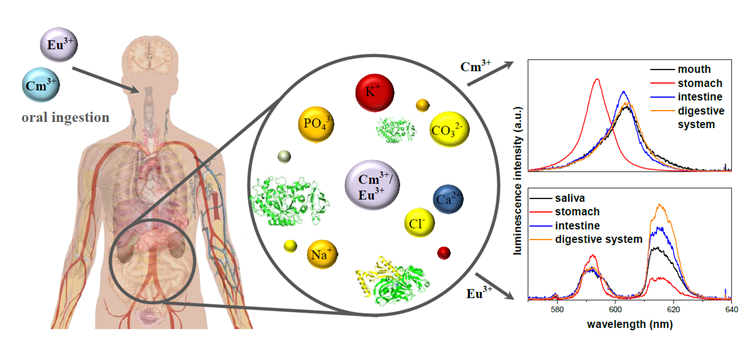Chemistry of the f-elements division
Coordination Chemistry of f-Elements with Bio-Related Ligands
Biomolecules, originating from microorganisms, plants or animals, are ubiquitous in the environment. There are many possible scenarios in which these molecules could interact with radioactive heavy metals, eventually influencing the migration behavior of these metal ions. It is therefore essential to investigate the interaction mechanisms between radioactive metals and biomolecules on a molecular level to understand the implication of biota and bio-related molecules for the biogeochemical cycle of radioactive heavy metals.
In case of incorporation into the human body, radioactive heavy metals potentially represent serious health risks due to their chemo- and radiotoxicity. In order to assess their toxicological behavior, such as transport, metabolism, deposition, and elimination from the human organisms, the understanding of their in vivo chemical speciation on a molecular level is crucial. Based on this background, we are actively investigating the chemical speciation of radioactive heavy metals, namely f-elements (actinides and lanthanides), under various in vivo conditions by combining different analytical techniques.
Ongoing projects
For a fundamental understanding of the interaction behavior of f-elements (i.e. actinides and lanthanides) with bio-related molecules, we are investigating the complexation of f-elements with a broad range of bio-related ligands, starting from small organic “model” molecules (e.g. carboxylates, amino acids, peptides, sugar phosphates) to bio-macromolecules (e.g. proteins).
In order to improve our comprehensive understanding of the behavior of f-elements in the human body, we are also investigating the chemical speciation of f-elements in various body fluids, e.g. gastrointestinal media. This is part of the joint project “TransAqua”.

Core techniques involved
- Time-resolved laser-induced fluorescence spectroscopy (TRLFS)
- X-ray absorption spectroscopy
- FT-IR spectroscopy
- NMR spectroscopy
Recent key publications
- "Trivalent f-elements in human saliva: A comprehensive speciation study by time-resolved laser-induced fluorescence spectroscopy and thermodynamic calculations",
Dalton Trans., 46(5), 1593-1605 (2017). - "Interaction of europium and curium with alpha-amylase",
Dalton Trans., 45(21), 8724-8733 (2016). - "Uranium(VI) binding forms in selected human body fluids: thermodynamic calculations versus spectroscopic measurements",
Chem. Res. Toxicol., 28(2), 238-247 (2015). - "Americium(III) and europium(III) complex formation with lactate at elevated temperatures studied by spectroscopy and quantum chemical calculations",
Dalton Trans., 43(29), 11221-11232 (2014). - "Curium(III) citrate speciation in biological systems: a europium(III) assisted spectroscopic and quantum chemical study",
Dalton Trans., 41(45), 13969-13983 (2012).

